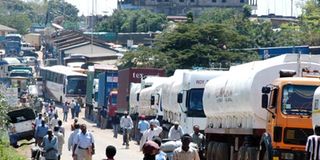Automation at border points to speed up cargo clearance

Trucks at Kenya’s Malaba border point transport goods to Uganda. Over the next three months all border points to the country are to switch from manual to electronic systems to clear goods through customs, a move expected to save billions of shillings lost annually through inefficiency and corruption. PHOTO/FILE
What you need to know:
- The Single Window System will create a platform for submission, receipt and processing of trade-related cargo clearance documents at a single entry point unlike now where businesses have to move back and forth through several departments.
Over the next three months all border points to the country are to switch from manual to electronic systems to clear goods through customs, a move expected to save billions of shillings lost annually through inefficiency and corruption.
The October 31 changeover is expected to boost trade by lowering the costs of import and export businesses. This could also ease Kenya’s global ranking in the World Bank’s annual survey on the ease of doing business, which currently stands at 121 out of 144 nations.
Known as the Kenya Electronic Single Window System and championed by the Kenya Trade Network Agency (KenTrade), the system will automate and speed up cargo clearance at all points of entry.
“The present global scenario in trade facilitation shows that countries that have embraced the Single Window System such as Singapore have made great economic strides and are very competitive,” KenTrade chairman, (Rtd) Gen Joseph Kibwana said.
Mr Kibwana said transition to the digital system would make trade simpler, faster and more cost-effective thus boosting the economy.
At present it takes between eight and 10 days to clear cargo at the port of Mombasa, while clearance at border entry points takes a minimum of two days. Freight handling at airports takes three days. But automation could drastically reduce these periods by up to 70 per cent.
“Clearance at the Mombasa port will come down to three days; at airports it shall be 24 hours while at border points it will take two hours to be cleared,” Kibwana said.
The Single Window System will create a platform for submission, receipt and processing of trade-related cargo clearance documents at a single entry point unlike now where businesses have to move back and forth through several departments.
According to KenTrade, there are over 10 institutions involved in the cargo clearing process, but the key agencies that issue clearances are Kenya Ports Authority, Kenya Police, and Kenya Bureau of Standards.
Others are the Kenya Plant Health Inspectorate service, Port Health Authority, Kenya Revenue Authority, Kenya Ports Health Authority and Pharmacy and Poison Board.
On average, seven different documents are exchanged between these departments resulting in delays and raising costs.
The system would be accessible online and it will include inbuilt checks to ensure objectivity in targeting and releasing of cargo by government agencies.
It is being benchmarked against compliant economies like Ghana, Senegal, Mozambique and Singapore, which has been ranked number 0ne for eight consecutive years in a World Bank survey on the ease of doing business.
While technological advancement brings with it job losses, KenTrade envisions increased job opportunities.
“An improved business environment will most likely lead to increased foreign direct investments hence creation of more jobs,” said Kibwana.
Kenya International Freight and Warehousing Association chairman Boaz Makomere said the introduction of the system will help address existing inefficiencies in trade logistics.




